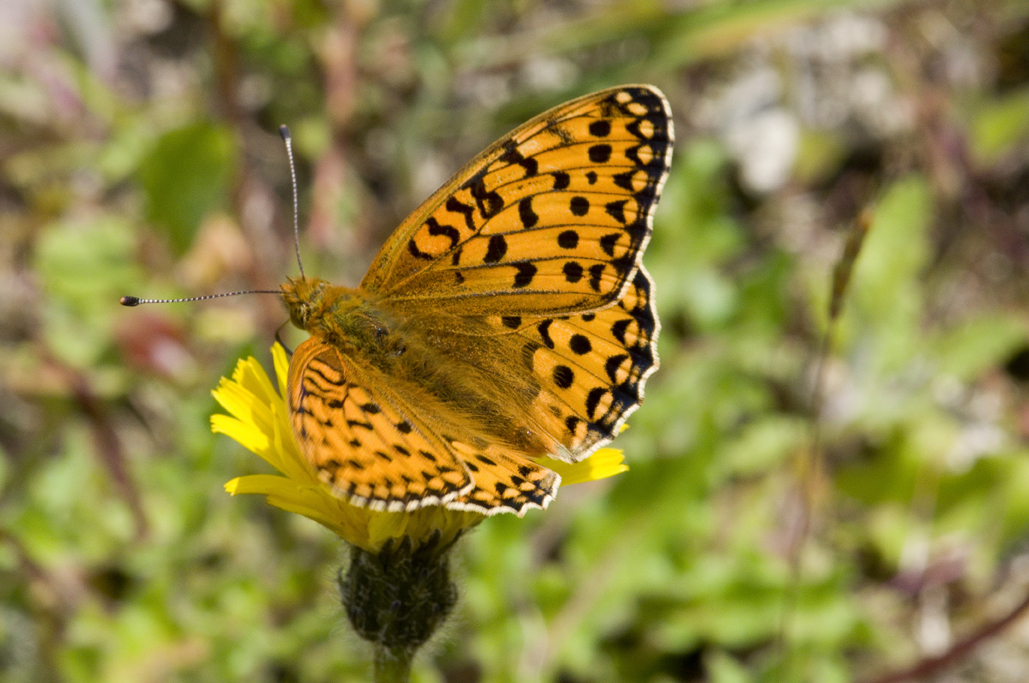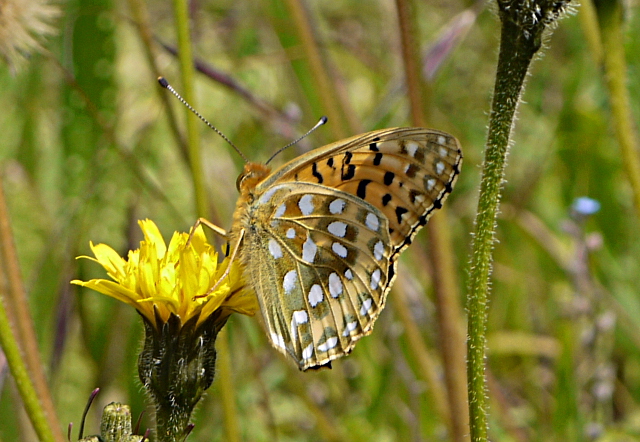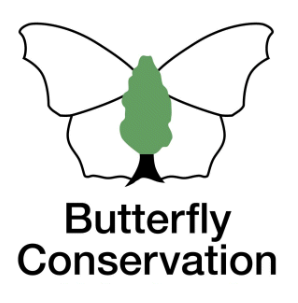Brown Argus
Brown Hairstreak
Chalkhill Blue
Clouded Yellow
Comma
Common Blue
Dark Green Fritillary
Dingy Skipper
Essex Skipper
Gatekeeper
Green Hairstreak
Green-veined White
Grizzled Skipper
Holly Blue
Large Skipper
Large White
Marbled White
Meadow Brown
Orange-tip
Painted Lady
Peacock
Purple Emperor
Purple Hairstreak
Red Admiral
Ringlet
Silver-washed Fritillary
Small Blue
Small Copper
Small Heath
Small Skipper
Small Tortoiseshell
Small White
Speckled Wood
Wall
White Admiral
White-letter Hairstreak
Extinct/rare immigrants
Dark Green Fritillary
Argynnis aglaja
General Distribution and Status
The Dark Green Fritillary is our most widespread fritillary being found in most of the British Isles but it is more local in central and eastern England. Although there was a contraction in range especially in the east in the last century, the impact has been far less dramatic than the other fritillaries. It inhabits woodland rides and clearings but unimproved grassland where violets grow is where most colonies are found so the effect of change of forestry practices would have minimal impact. However, intensive farming management and lack of grazing would have destroyed many colonies as grassland was 'improved' through ploughing, seeding and application of fertilisers. In spite of this, the butterfly has done remarkably well since the 1970s with abundance more than doubled at monitored sites although the range has expanded only in the last ten years or so (Fox et al.). This species has a strong flight but it is surprisingly not very mobile so colonisation of new sites is relatively slow. The situation in Hertfordshire and Middlesex is similar but there are too few colonies to determine a definitive trend although there are signs that it could be improving here as well. Sites such as Aldbury Nowers, Hexton Chalk Pit and Therfield Heath are the best places to find the butterfly in the two counties but a new colony was discovered in the Aston area in 2022 which is worth exploring further.
| United Kingdom | Herts & Middx | |||
| Distribution | 1976-2019 | -40% | 1980-2015 | -8% |
| Average 10-year trend | -10% | 2006-2015 | +50% | |
| 2024 since 2015-19 | -50% | |||
| Abundance | 1976-2024 | +249% | 1980-2015 | 0% |
| 2015-2024 | -11% | 2006-2015 | +67% | |
| 2023-2024 | -55% | 2024 since 2015-19 | -64% | |
UK distribution map
UKBMS Species summary
Habitat Requirements
It occurs chiefly on calcareous grassland but may also be found on grassland with bracken, dunes and moorland.
Larval Foodplants
Common Dog Violet Viola riviniana, Marsh Violet V. palustris on moorland and Hairy Violet V. hirta on the chalk.
Adult Food Sources
Red Valerian Centranthus ruber (50), Thisles Cirsium sp. (18), Buddleia Buddleja davidii (8).
Historical Records
Gibbs' 1902 report excludes any records from the Stevenage area but the butterfly was present by the 1930s as Foster's 1937 publication mentions it being found at Graveley and Knebworth. In 1941, specimens were caught in the Walkern area (Birdsall) and in 1943 it was seen on 3 July at Knebworth Woods where Roger Ferry also found it and although no date was given it was also probably in the 1940s. A big decline occurred since the 1950s with no evidence of any sightings in the county until 1975 when the species was recorded in the Tring area and at Ickleford railway cutting (Waterton).
Local Distribution and Abundance
Prior to 2022, only six records of this species have been reported in the area during the survey. Two, likely to relate to the same individual were seen on 24 and 26 July 2002 on the western edge of Newton Wood by the public footpath where there are patches of bracken. Trevor Chapman saw the specimen on 24 July with confirmation from Keith Mitchell two days later. On 12 August 2017 during a Wider Countryside Butterfly Scheme walk, a specimen was reported on bracken in the Newton Wood area. In 2020 and 2021, three reports came from fields off the Walkern Road near High Wood, Benington (TL2822). Even better was that on two occasions in June 2022, an excess of 50 individuals were seen here from 11 reports overall. Had this site been missed because some were reported in the Walkern area in 1941 (Birdsall)?. Sadly, poor weather in 2023 and 2024 resulted in only three sightings in 2023 and none in 2024.

Knebworth Park transect 1996-2010 and 2017-2024
The first record of this butterfly on this transect occurred on 3 July 2022 in the field south of Burleighcroft Wood by the footpath.Life History
The Dark Green Fritillary is on the wing from June to August with a peak around the middle of July. The eggs are laid on or near violets. After the larva
emerges it eats the eggshell and immediately enters hibernation. On emergence in the spring the larvae eat the leaves. When fully grown it creates a tent, using the
leaves and other vegetation, in which a pupa will be formed.
Behaviour/Observation notes
This species is a low-flying insect with males spending much time patrolling over the vegetation in search for females which are more inconspicuous. However, in early morning and evening, it is often found feeding on flowers like thistles and knapweeds to provide opportunities for good photographs although to photograph the undersides you may need to wait until the middle of the day when the temperature rises (Riley).
Variations/Aberrations
There are no known reports of variations or aberrations for the butterfly in the county.
Find out more on the UK Butterflies website
References

Sharpenhoe Clappers 14 Jun 2011 © Bob Clift

Sharpenhoe Clappers 14 Jun 2011




